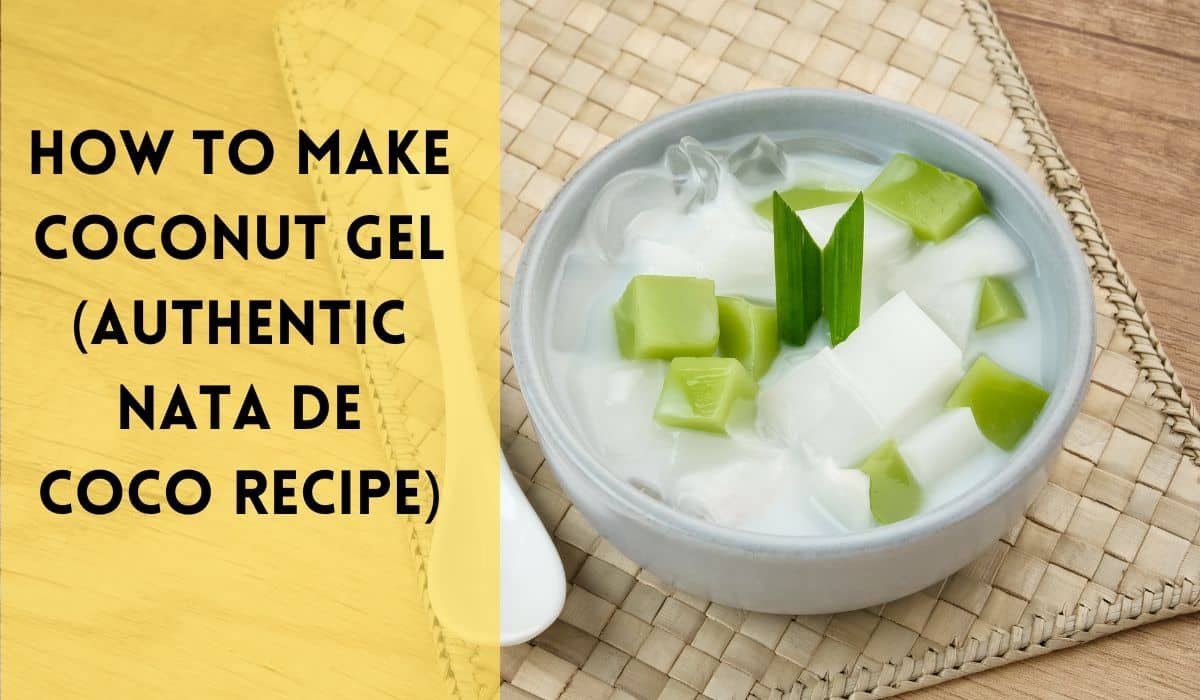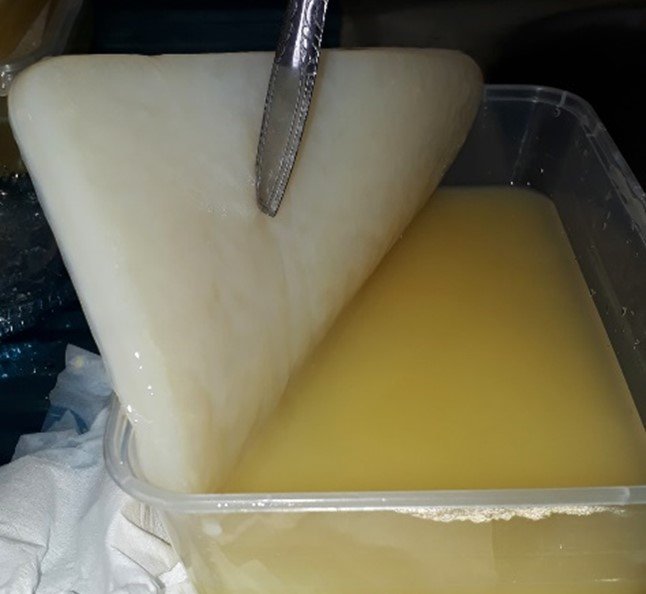How To Make Coconut Gel (Authentic Nata de Coco Recipe)

Are you ready to explore the delightful world of Filipino desserts? Dive into our recipe on how to make Coconut Gel, also known as Nata de Coco, right at home with an authentic recipe.
Made from fermented coconut water, Nata de Coco is a popular ingredient in various desserts and beverages across Southeast Asia.
Whether you’re looking to impress guests or simply indulge in a homemade tropical delight, this step-by-step recipe will help you create the perfect batch of coconut gel.

Authentic Nata De Coco Recipe
Equipment
- 1 Large casserole
- 1 Cheesecloth or fine mesh sieve
- 1 Rubber band or string
- 1 Glass container for fermentation
Ingredients
- 500 ml coconut water
- 200 gram sugar
- 10 ml vinegar
- 10 ml Starter bacteria (Acetobacter Xylinum)
Instructions
- Pour the water into a large casserole
- Boil the coconut water
- Add the sugar and the vinegar into the boiling water. Stir until the sugar is completely dissolved.
- Remove the casserole from the heat and pour the mixture to a glass bowl. Wait for the temperature to drop to 30 Celsius degrees.
- Pour 10 ml of the starter bacteria in the water
- Cover the container with cheesecloth or a thin fabric, securing it with a rubber band or string. This allows air circulation while preventing contaminants from entering.
- Let Rest for 10 – 12 days
- After a few days, you should start to see small jelly-like pieces forming. The fermentation is complete when the liquid has thickened, and the nata de coco pieces are firm and translucent.
- Once the fermentation is complete, carefully strain the liquid through a fine mesh sieve or colander to separate the nata de coco from the liquid. Rinse the nata de coco pieces under cold water to remove any residual acidity.
- To eliminate any remaining acidic taste or smell, soak the nata de coco cubes in several changes of fresh water. The soaking process typically takes at least 2 days, but you can adjust the duration based on your preference.
Video
Notes
- Use fresh coconut water for the best results.
- Ensure cleanliness and sterilize equipment to minimize the risk of contamination during fermentation.
- Monitor the fermentation process regularly to adjust the time as needed.
- Experiment with different flavors by adding sugar or other sweeteners during the soaking process.
- Store the Nata de Coco in an airtight container in the refrigerator to preserve freshness.
- You can buy Acetobacter Xylinum or from Custom Probiotics.
Nata De Coco Serving Suggestions
Ok, so now you’ve made Nata De Coco? How do you serve it? Here are some delicious serving suggestions for enjoying Nata de Coco:
Desserts
- Fruit Salad: Mix Nata de Coco with fresh fruits like mangoes, strawberries, kiwis, or pineapples for a refreshing and colorful fruit salad. Add a drizzle of condensed milk or honey for extra sweetness.
- Panna Cotta: Fold Nata de Coco cubes into a creamy panna cotta mixture before chilling. The chewy texture of the Nata de Coco complements the smooth panna cotta beautifully.
- Ice Cream Topping: Top your favorite ice cream with Nata de Coco for an interesting textural contrast and a tropical flavor boost.
Beverages
- Bubble Tea: Add Nata de Coco to your bubble tea for a unique and chewy addition to the popular drink.
- Dalgona Coffee: Elevate the trendy Dalgona Coffee by serving it with coffee-flavored Nata de Coco for an extra special treat.
- Fruit Juices: Mix Nata de Coco into your favorite fruit juices for a fun and refreshing beverage with a satisfying chew.
Other Ideas
- Yogurt Topping: Stir Nata de Coco into your yogurt for added texture and a hint of sweetness.
- Baked Goods: Incorporate Nata de Coco into cakes, muffins, or bread for a unique twist on traditional baked goods.
- Savory Dishes: Experiment with using Nata de Coco in savory dishes like salads or as a garnish for grilled meats for an unexpected pop of sweetness.
Remember, Nata de Coco is incredibly versatile and can be used in a wide variety of dishes and drinks. Its unique chewy texture and mild flavor make it a fun and exciting ingredient to play with in the kitchen.
What is Nata de coco?
Nata de coco, also known as coconut gel, is a chewy and jelly-like snack made from coconut water. According to Wikipedia, Nata de coco was created in the Philippines by Teódula Kalaw África in 1949.

She worked for the National Coconut Corporation and wanted to make something similar to nata de piña, a traditional Filipino dessert made from pineapples. Since pineapples were seasonal and not always available, she used coconut water instead.
The process of making nata de coco starts with extracting coconut water. Then, it is fermented using special bacteria that turn it into a gel-like substance.
Once formed, this layer is removed from the surface, thoroughly cleaned to get rid of any acidic taste, cut into pieces, and then packaged.

By 1954, nata de coco quickly became popular on its own. Its production was commercialized when the Philippine Coconut Administration helped local farmers start making it in Laguna. Today, besides being enjoyed in the Philippines, it’s also produced in other countries like Thailand and Indonesia.
Nata de coco can be eaten alone as a sweet treat or added to various dishes such as ice cream toppings or fruit cocktails due to its sweet flavor and fun texture.
Is Nata De Coco Healthy?
Nata de coco is loved by kids for its sweet taste and fun texture. But is it healthy? Can you consume it on a daily basis?
Nata De Coco is not only tasty but also offers some health benefits. For example, it is low in calories and contains traces of vitamins and minerals. These nutrients can help boost your immune system which is especially good for growing children.
One of the best things about nata de coco is that it’s high in dietary fiber. [1]
This type of fiber can help with digestion and even support weight loss efforts because it helps you feel full longer after eating.
For those who have diabetes or are watching their sugar intake, nata de coco can be a safe choice if eaten in moderation since it’s low in fat.
However, while nata de coco has these benefits, it doesn’t provide all the nutrients your body needs on its own. So, don’t get any ideas to live on just nata de coco because you will soon end up being malnutritional.
It’s also important to watch out for commercial versions that might have added sugars and sweeteners, which increase calorie content.
Eating nata de coco as part of a balanced diet – meaning you eat other foods rich in various nutrients too – is the best way to enjoy it without consuming too much sugar or missing out on other essential vitamins and minerals.
Nata De Coco Nutrition Profile
Although it was hard for me to find a single authoritative source about Nata De Coco’s nutrition facts, here’s a table summarizing the nutrition profile of Nata de Coco per 100g.
| Nutrient | Value (per 100g) |
|---|---|
| Calories | 45 Kcal |
| Carbohydrates | 12g |
| Fiber | 1 g |
| Sugars | 11g |
| Protein | 0.66g |
| Fat | 0.16g |
| Sodium | 103mg |
| Potassium | 230mg |
| Calcium | 22mg |
| Vitamin C | 2.2mg |
| Vitamin D | – |
| Iron | – |
Sources:
- https://www.myfitnesspal.com/food/nutrition-calories/nata-de-coco-66543833386989
- https://www.carbmanager.com/food-detail/md:df7fdc1c2eaa10fe60cbc1d796431af8/nata-de-coco-coconut
Please note that the values provided are based on the search results and might vary depending on the specific product or brand of Nata de Coco.
Final Words
We hope you enjoyed making and tasting your very own Coconut Gel (Nata de Coco)! Your feedback is invaluable to us, so please take a moment to rate this recipe and share your thoughts in the comments below. Did it turn out as you expected?
Do you have any tips or tweaks that made it even better? Additionally, if you know any variations or creative ways to use Nata de Coco in other dishes, we’d love to hear about them!
Sharing your experiences can help fellow readers enhance their culinary experiments. Thank you for trying out our recipe, and we look forward to hearing from you!
Check our other recipes
